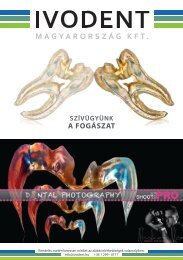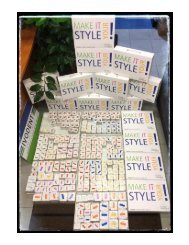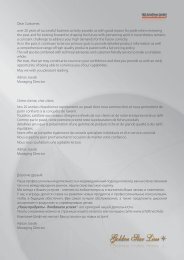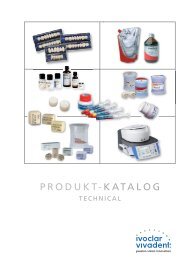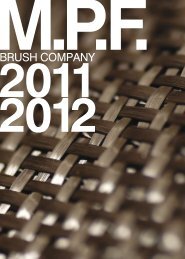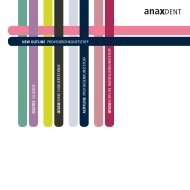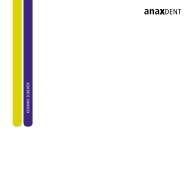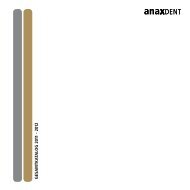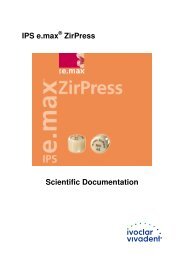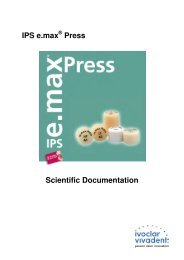Scientific Documentation
Create successful ePaper yourself
Turn your PDF publications into a flip-book with our unique Google optimized e-Paper software.
<strong>Scientific</strong> <strong>Documentation</strong>
<strong>Scientific</strong> <strong>Documentation</strong> IPS InLine ® System Page 2 of 36<br />
Table of Contents<br />
1. Introduction......................................................................................................................3<br />
2. Basic materials science ..................................................................................................5<br />
2.1 Fabrication of feldspar ceramics...........................................................................................5<br />
3. Material description.........................................................................................................6<br />
3.1 IPS InLine – the conventional metal-ceramic.......................................................................6<br />
3.2 IPS InLine PoM – the press-on-metal ceramic .....................................................................7<br />
3.3 Shade, Stains and Glaze materials........................................................................................8<br />
3.4 Metal-ceramic bond ................................................................................................................8<br />
4. Technical Data ...............................................................................................................11<br />
5. Investigations of the material properties .....................................................................17<br />
5.1 Biaxial flexural strength (internal measurement) ..............................................................17<br />
5.2 Material data of IPS InLine PoM – Press-on-Metal ceramic..............................................17<br />
5.3 Volume shrinkage .................................................................................................................18<br />
5.4 Thermal expansion ...............................................................................................................19<br />
5.5 Physical properties...............................................................................................................21<br />
6. In vitro investigation......................................................................................................23<br />
6.1 Introduction ...........................................................................................................................23<br />
6.2 In vitro wear tests in the chewing simulator ......................................................................23<br />
6.3 Metal-ceramic bond ..............................................................................................................26<br />
6.4 List of alloys for the IPS InLine System..............................................................................28<br />
6.5 Metal-ceramic bond (re-cast alloys)....................................................................................29<br />
7. Clinical evaluation of the IPS InLine System ...............................................................30<br />
7.1 Clinical data ...........................................................................................................................30<br />
7.2 Clinical studies with IPS InLine (conventional metal-ceramic)........................................30<br />
7.3 Clinical studies with IPS InLine PoM (Press-on-Metal ceramic) ......................................30<br />
8. Biocompatibility.............................................................................................................32<br />
8.1 Introduction ...........................................................................................................................32<br />
8.2 Biocompatibility ....................................................................................................................32<br />
8.3 Chemical solubility ...............................................................................................................33<br />
8.4 In vitro cytotoxicity ...............................................................................................................33<br />
8.5 Radioactivity..........................................................................................................................33<br />
8.6 Sensitization, irritation .........................................................................................................34<br />
8.7 Biological risk to user and patient ......................................................................................34<br />
8.8 Conclusion.............................................................................................................................34<br />
9. Literature........................................................................................................................35
<strong>Scientific</strong> <strong>Documentation</strong> IPS InLine ® System Page 3 of 36<br />
1. Introduction<br />
IPS InLine One (one-layer metal-ceramic), IPS InLine (conventional metal-ceramic) and IPS<br />
InLine PoM (Press-on-Metal) are veneering ceramics for alloys. The materials are leucite<br />
ceramics.<br />
IPS InLine One<br />
IPS InLine<br />
IPS InLine PoM<br />
is a one-layer metal-ceramic. IPS InLine One are one-layer materials<br />
which are based on the existing raw materials used for IPS InLine.<br />
These layering materials are named "Dentcisal" – they represent a<br />
combination of dentin and incisal materials and feature corresponding<br />
properties in terms of chroma and translucency. These components<br />
allow users to create lifelike restorations quickly and efficiently.<br />
is a conventional metal-ceramic. Suitable manufacturing processes and<br />
a specific grain size distribution form the basis for the development. The<br />
result is a product featuring good firing stability, low shrinkage and easy<br />
processing for the fabrication of highly esthetic restorations.<br />
is a Press-on-Metal ceramic. Thus, it is possible to optimally combine the<br />
advantages of the casting and the press techniques. Compared to the<br />
layering technique, the wax-up of IPS InLine PoM in the press-on-metal<br />
technique corresponds to the final shape. There is no need for cut-back<br />
or ceramic layering. Apply the opaquer, complete the wax-up, press the<br />
fully anatomical restoration and characterize it with the stain materials<br />
and glaze.<br />
The systems concept:
<strong>Scientific</strong> <strong>Documentation</strong> IPS InLine ® System Page 4 of 36<br />
Indications:<br />
IPS InLine One<br />
- One-layer veneering ceramic for the most popular dental alloys in the CTE range of<br />
13.8 – 15.0 x 10 -6 /K (25-500°C)<br />
IPS InLine<br />
- Conventional multi-layer veneering ceramic for the most popular dental alloys in the<br />
CTE range of 13.8 – 15.0 x 10 -6 /K (25-500°C)<br />
- Veneers on refractory dies<br />
IPS InLine PoM<br />
- Fully anatomical pressing on masked (opaquerized) metal crown and bridge<br />
frameworks<br />
- Pressing on dental alloys in the CTE range of 13.8 – 14.5 x 10 -6 /K (25-500°C) with a<br />
silver content of
<strong>Scientific</strong> <strong>Documentation</strong> IPS InLine ® System Page 5 of 36<br />
2. Basic materials science<br />
Conventional dental ceramics are based on a ternary materials system consisting of<br />
clay/kaolin, feldspar and quartz. Dental ceramics considerably differ from household<br />
ceramics. As illustrated in the figure below (Fig. 1), dental ceramics have a high content of<br />
feldspar and a low content of kaolin. Exactly the opposite is true for household ceramics.<br />
Fig. 2: Phase diagram orthoclase-albite [2]<br />
Fig. 1: Ternary materials system: clay - feldspar -<br />
quartz [1]<br />
Feldspathic ceramics are in part based on naturally occurring raw materials (feldspar).<br />
Natural feldspars are, for example, potassium feldspar (K2Al 3 Si6O 8 ; orthoclase) and<br />
sodium feldspar (NaAlSi 3 O 8 ; albite). Potassium feldspar imparts dental ceramics with high<br />
hardness, increased thermal expansion and chemical durability. In general, dental ceramics<br />
contain a high proportion of potassium feldspar. Potassium feldspar is responsible for the<br />
formation of leucite crystals, which provide resistance to excessive pyroplastic flow during<br />
the melting process. The constitution diagram (Fig. 2) shows that potassium feldspar does<br />
not immediately become a liquid when the melting point is reached. Instead, a mixture<br />
consisting of a liquid phase and leucite crystals forms over a fairly wide temperature range.<br />
This phase exhibits a very high viscosity, i.e. it is resistant to flow. The wide firing range<br />
imparts the fired objects with a favourable stability [1; 3].<br />
The leucite crystals embedded in the glass matrix increase the strength of the restoration.<br />
The propagation of cracks is slowed or deflected by the leucite crystals. In the process, the<br />
crystalline phase absorbs fracture energy. As a result, the propagation of cracks is arrested<br />
or slowed down.<br />
2.1 Fabrication of feldspar ceramics<br />
In contrast to synthetic leucite ceramics, feldspar ceramics contain naturally occurring<br />
feldspar as the base material.<br />
Natural feldspar and glass-forming chemicals are milled, mixed and melted. Quenching this<br />
melt results in the formation of a glass with the desired chemical composition. Renewed<br />
milling of the glass (possibly in combination with other glass powders) produces a glass<br />
powder which is the basis for further processing of the final leucite ceramic. The glass<br />
powders are mixed and treated according to a procedure which is subsequently defined<br />
(sintering / tempering). Thus, the content of leucite in the end product is controlled. In order
<strong>Scientific</strong> <strong>Documentation</strong> IPS InLine ® System Page 6 of 36<br />
to stop the precipitation process of leucite at the right time, the mixture is quenched. The<br />
final product is obtained by further grinding and sieving.<br />
natural feldspar + glass former glass x leucite+glass y<br />
(leucite ceramic)<br />
SiO 2<br />
+<br />
Al 2 O 3<br />
Na 2 CO 3<br />
CaCO 3<br />
B 2 O 3<br />
etc.<br />
KAlSi 3 O 8 [Glass] KAlSi 2 O 6 + [Glass]<br />
Fig. 3: Fabrication of feldspar ceramics<br />
3. Material description<br />
3.1 IPS InLine – the conventional metal-ceramic<br />
The microstructure of IPS InLine consists of a glassy matrix and leucite crystals.<br />
The SEM images of polished and etched surfaces reveal the microstructure of the material.<br />
Depending on the magnification, different phases (glass/crystal), grain sizes, grain<br />
boundaries and defects (e.g. pores, cracks) are discernible, as shown in the following set of<br />
images (Figs 4 to 6). Leucite is the result of surface crystallization. Therefore, the leucite<br />
crystals are located along the grain boundaries. The small leucite crystals that are arranged<br />
like strings of beads show the former grain boundaries prior to tempering/sintering (see Figs<br />
7a and 7b).<br />
5 µm<br />
Fig. 4: IPS InLine Dentin A2; 5000x, etched. A<br />
specially designed etching technique dissolves<br />
the leucite crystals more quickly than the glass.
<strong>Scientific</strong> <strong>Documentation</strong> IPS InLine ® System Page 7 of 36<br />
Leucite Crystals<br />
5 µm<br />
5 µm<br />
Figs 5 and 5a: IPS InLine Dentin A3; 5000x, etched. Glass matrix and leucite crystals are visible.<br />
Both images show the same section. In Fig. 5b, the leucite crystals have been highlighted.<br />
Fig. 6: Middle section of Fig. 5 (magnified) The striation in the dissolved<br />
areas shows the lamellar structure of leucite crystals – a result of<br />
dendritic growth.<br />
former grain boundaries<br />
5 µm<br />
5 µm<br />
Figs 7a and 7b: IPS InLine Incisal TI1; 5000x Same section, image 7b shows the grain boundaries.<br />
3.2 IPS InLine PoM – the press-on-metal ceramic<br />
The Press-on-Metal ingot is composed of a leucite-containing ceramic (Fig. 8), the optical<br />
properties of which are optimized by small shares of further crystal phases.
<strong>Scientific</strong> <strong>Documentation</strong> IPS InLine ® System Page 8 of 36<br />
Fig. 8: Microstructure of IPS InLine PoM (etched, 10 sec with 3% hydrofluoric acid)<br />
The colour of the press material is completed by ceramic colour pigments. The base<br />
material in powder form is fired to monolithic press ingots after shaping them under<br />
vacuum. A homogeneous and non-porous microstructure is achieved by the press<br />
procedure. The firing stability of the ingot allows Touch Up materials, Shades, Stains and<br />
Glaze materials to be applied without compromising the accuracy of fit of the restoration.<br />
The Touch Up materials are leucite-containing ceramics which are pigmented according to<br />
the ingot shade concept. The coefficient of thermal expansion and firing temperature are<br />
adjusted to an application in the cervical and incisal area after pressing and prior to the<br />
characterization firing cycles.<br />
3.3 Shade, Stains and Glaze materials<br />
The new Shades, Stains and Glaze materials are based on very fine-grained glass<br />
powders, which are sintered at low temperatures. While the Glaze material is composed of<br />
the pure, unpigmented glass powder, specifically prepared colour pigments are added to<br />
the Shades and Stains. The powder materials are dispersed to a paste with organic<br />
thickening agents in order to facilitate the application for the dental technician.<br />
3.4 Metal-ceramic bond<br />
3.4.1 Bond mechanisms<br />
Good wettability of the alloy surface by the opaquer, which is very viscous at high<br />
temperatures, is a prerequisite for an optimal bond. Basically, however, the metal-ceramic<br />
bond is based on adhesion, i.e. the bonding effect between a solid interface (here: metal<br />
surface) and a second phase (here: the ceramic). The most important of the numerous<br />
adhesive mechanisms are described below 1 :<br />
– Adhesion by mechanical bond<br />
The ceramic bonds mechanically to the metal surface by filling depressions and/or<br />
enclosing protruding structures and anchor points, which are present on the surface after<br />
metal conditioning. In addition to this mechanical bond, the ceramic demonstrates a certain<br />
compressive strain, since its coefficient of thermal expansion is lower than that of the alloy.<br />
1 "Focus on: Alloy/ceramic bond, IPS InLine“, Ivoclar Vivadent AG, 2005
<strong>Scientific</strong> <strong>Documentation</strong> IPS InLine ® System Page 9 of 36<br />
– Adhesion by chemical bond<br />
Processes such as chemical reactions, dissolution processes, redox processes, diffusion<br />
and precipitation result in the formation of a characteristic transition area at the interface<br />
between metal and ceramic. Particularly in the presence of non-precious alloy components,<br />
a certain saturation of both metal and ceramic with metal oxides occurs. Ideally, this results<br />
in the formation of an oxide monolayer, which is a component of both the metal and the<br />
ceramic. The resulting bond energies and electronic structures are then identical at each<br />
point of the interface. The prerequisite for this behaviour is an oxide layer that is formed on<br />
the metal surface during oxide firing.<br />
This bonding mechanism can be depicted using the following model.<br />
Fig. 9: Model of the chemical bond 2<br />
The chemical bond is initiated by oxygen atoms which are present in both the metal layer<br />
and the ceramic and thus link the two materials.<br />
– Adhesion by intermolecular forces<br />
Short-range forces act between the alloy and ceramic, which in their sum are called Van<br />
der Waals forces. Their contribution to the adhesive bond is smaller than that of the<br />
mechanical and chemical bond.<br />
3.4.2 Bond of metal to IPS InLine System<br />
A metal-ceramic restoration is a material composition that is based on a durable bond<br />
between an alloy and a ceramic material. The interface between metal and ceramic is<br />
formed by the opaquer, which, if carefully applied and fired, produces a sound bond<br />
between the two materials. The following images (Fig. 10, Fig. 11) show the transition areas<br />
between alloy, opaquer and ceramic for a high-gold and a base-metal alloy. The fine-grain<br />
structure of the opaquer is clearly visible. At high magnification, the alloy surface appears<br />
rough and covered with depressions filled with ceramic material. This pattern plays an<br />
important role for the metal-ceramic bond.<br />
The quality of the metal-ceramic bond for IPS InLine (Fig. 10) and IPS InLine PoM (Fig. 11)<br />
is good and very homogeneous.<br />
2 Schnettger A., Fachhochschule Osnabrück 2004
<strong>Scientific</strong> <strong>Documentation</strong> IPS InLine ® System Page 10 of 36<br />
Fig. 10: Bond of Brite Gold XH / IPS InLine<br />
Fig. 11: Bond of IPS d.SIGN30 / IPS InLine PoM
<strong>Scientific</strong> <strong>Documentation</strong> IPS InLine ® System Page 11 of 36<br />
4. Technical Data<br />
IPS InLine<br />
Dentin, Deep Dentin, Occlusal Dentin, Incisal, Transpa Incisal, Cervical Incisal,<br />
Transpa, Gingiva, Intensive Gingiva, Mamelon, Add-On Margin<br />
Standard composition:<br />
(in wt%)<br />
SiO 2 59.5 - 65.5<br />
Al 2 O 3 13.0 - 18.0<br />
K 2 O 10.0 - 14.0<br />
Na 2 O 4.0 - 8.0<br />
Other oxides 0.0 - 4.0<br />
Pigments 0.0 - 2.0<br />
Physical properties:<br />
In accordance with:<br />
ISO 6872 Dental ceramic<br />
ISO 9693 Metal-ceramic dental restorative systems<br />
Flexural strength<br />
Chemical solubility<br />
Coefficient of thermal expansion (25 - 500 °C) 2 firings<br />
4 firings<br />
Glass transition temperature<br />
2 firings<br />
4 firings<br />
80 ± 20 MPa<br />
< 100 µg/cm²<br />
12.60 ± 0.5<br />
13.20 ± 0.5<br />
585 ± 10<br />
585 ± 10<br />
10 -6 K -1<br />
10 -6 K -1<br />
°C<br />
°C
<strong>Scientific</strong> <strong>Documentation</strong> IPS InLine ® System Page 12 of 36<br />
IPS InLine One<br />
Dentcisal<br />
Standard composition:<br />
(in wt%)<br />
SiO 2 59.5 - 65.5<br />
Al 2 O 3 13.0 - 18.0<br />
K 2 O 10.0 - 14.0<br />
Na 2 O 4.0 - 8.0<br />
Other oxides 0.0 - 4.0<br />
Pigments 0.0 - 2.0<br />
Physical properties:<br />
In accordance with:<br />
ISO 6872 Dental ceramic<br />
ISO 9693 Metal-ceramic dental restorative systems<br />
Flexural strength<br />
Chemical solubility<br />
Coefficient of thermal expansion (25 - 500 °C)<br />
Glass transition temperature<br />
2 firings<br />
4 firings<br />
2 firings<br />
4 firings<br />
80 ± 20 MPa<br />
< 100 µg/cm²<br />
12.60 ± 0.5<br />
13.20 ± 0.5<br />
585 ± 10<br />
585 ± 10<br />
10 -6 K -1<br />
10 -6 K -1<br />
°C<br />
°C
<strong>Scientific</strong> <strong>Documentation</strong> IPS InLine ® System Page 13 of 36<br />
IPS InLine PoM Ingot<br />
PoM BL, PoM 1 - 6<br />
Standard composition:<br />
(in wt%)<br />
SiO 2 50.0 - 65.0<br />
Al 2 O 3 8.0 - 20.0<br />
Na 2 O 4.0 - 12.0<br />
K 2 O 7.0 - 13.0<br />
Other oxides, fluoride 0.0 - 6.0<br />
Pigments 0.0 - 3.0<br />
Physical properties:<br />
In accordance with:<br />
ISO 6872 Dental ceramic<br />
ISO 9693 Metal-ceramic dental restorative systems<br />
Flexural strength<br />
Chemical solubility<br />
Coefficient of thermal expansion<br />
(25-500 °C)<br />
Glass transition temperature<br />
2 firings<br />
4 firings<br />
2 firings<br />
4 firings<br />
130 ± 20 MPa<br />
13.0 ± 0.5<br />
13.3 ± 0.5<br />
< 60 µg/cm²<br />
575 ± 10<br />
575 ± 10<br />
10 -6 K -1<br />
10 -6 K -1<br />
°C<br />
°C
<strong>Scientific</strong> <strong>Documentation</strong> IPS InLine ® System Page 14 of 36<br />
IPS InLine PoM Touch Up<br />
PoM Touch Up BL, PoM Touch Up 1 - 6<br />
Standard composition:<br />
(in wt%)<br />
SiO 2 50.0 - 65.0<br />
Al 2 O 3 8.0 - 20.0<br />
Na 2 O 4.0 - 12.0<br />
K 2 O 7.0 - 13.0<br />
Other oxides, fluoride 0.0 - 6.0<br />
Pigments 0.0 - 3.0<br />
Physical properties:<br />
In accordance with:<br />
ISO 6872 Dental ceramic<br />
ISO 9693 Metal-ceramic dental restorative systems<br />
Flexural strength<br />
Chemical solubility<br />
Coefficient of thermal expansion<br />
(25-500 °C)<br />
Glass transition temperature<br />
2 firings<br />
4 firings<br />
2 firings<br />
4 firings<br />
80 ± 20 MPa<br />
12.0 ± 0.5<br />
12.6 ± 0.5<br />
< 60 µg/cm²<br />
540 ± 10<br />
540 ± 10<br />
10 -6 K -1<br />
10 -6 K -1<br />
°C<br />
°C
<strong>Scientific</strong> <strong>Documentation</strong> IPS InLine ® System Page 15 of 36<br />
IPS InLine System<br />
Opaquer, Intensive Opaquer,<br />
Opaquer F<br />
Standard composition: (in wt%) Opaquer<br />
Intensive<br />
Opaquer<br />
Opaquer F<br />
Al 2 O 3 8.0 - 14.0 8.0 - 14.0<br />
SiO 2 35.0 - 55.0 35.0 - 55.0<br />
K 2 O 7.5 - 13.0 7.5 - 13.0<br />
Na 2 O 3.5 - 5.5 3.5 - 5.5<br />
ZrO 2 14.0 - 39.0 0.0 - 2.0<br />
Other oxides 0.0 - 3.0 0.0 - 3.0<br />
Pigments 4.0 - 20.0 4.0 - 20.0<br />
Glycols 26.0 26.0<br />
Physical properties:<br />
In accordance with:<br />
ISO 6872 Dental ceramic<br />
ISO 9693 Metal-ceramic dental restorative systems<br />
Opaquer<br />
Intensive Opaquer<br />
Opaquer F<br />
Chemical solubility < 100 < 100 µg/cm²<br />
Coefficient of thermal expansion (25 - 500 °C)<br />
2 firings<br />
4 firings<br />
Glass transition temperature 2 firings<br />
4 firings<br />
13.50 ± 0.5<br />
13.70 ± 0.5<br />
605 ± 10<br />
605 ± 10<br />
13.60 ± 0.5<br />
13.90 ± 0.5<br />
590 ± 10<br />
590 ± 10<br />
10 -6 K -1<br />
10 -6 K -1<br />
°C<br />
°C
<strong>Scientific</strong> <strong>Documentation</strong> IPS InLine ® System Page 16 of 36<br />
IPS InLine System<br />
Shade, Stains, Glaze materials<br />
Standard composition:<br />
Shades: Stains [wt%] Glaze [wt%]<br />
[in wt%]<br />
SiO 2 61.0 - 68.0 61.0 - 68.0 61.0 - 68.0<br />
Al 2 O 3 5.0 - 8.0 5.0 - 8.0 5.0 - 8.0<br />
Na 2 O 5.0 - 8.0 5.0 - 8.0 5.0 - 8.0<br />
K 2 O 5.0 - 8.0 5.0 - 8.0 5.0 - 8.0<br />
ZnO 2.0 - 4.0 2.0 - 4.0 2.0 - 4.0<br />
Other oxides 3.5 - 17.0 3.5 - 17.0 3.5 - 17.0<br />
Pigments 0.4 - 25.0 0.4 - 25.0 0.0 - 1.0<br />
Glycols 30.0 – 40.0 30.0 – 40.0 30.0 – 40.0<br />
Physical properties:<br />
In accordance with:<br />
ISO 6872 Dental ceramic<br />
ISO 9693 Metal-ceramic dental restorative systems<br />
Shades Stains Glazing<br />
Chemical solubility µg/cm² < 100 < 100 < 100<br />
Coefficient of thermal expansion 2 firings<br />
(25 - 400 °C) 4 firings<br />
10 -6 K -1 9.4 ± 0.5<br />
10 -6 K -1 9.6 ± 0.5<br />
9.4 ± 0.5<br />
9.6 ± 0.5<br />
9.4 ± 0.5<br />
9.6 ± 0.5<br />
Glass transition temperature °C 475 ± 10 475 ± 10 470 ± 10
<strong>Scientific</strong> <strong>Documentation</strong> IPS InLine ® System Page 17 of 36<br />
5. Investigations of the material properties<br />
5.1 Biaxial flexural strength (internal measurement)<br />
The biaxial flexural strength of the IPS InLine range of products has been determined by<br />
Ivoclar Vivadent according to EN ISO 9693.<br />
Material<br />
Biaxial flexural<br />
strength<br />
Threshold value<br />
EN ISO 9693<br />
IPS InLine Opaquer A3 168 MPa 50 MPa<br />
IPS InLine Dentin A2 92 MPa 50 MPa<br />
IPS InLine Incisal TI2 96 MPa 50 MPa<br />
Tab. 1: Biaxial flexural strength values of the IPS InLine products (internal measurement, Ivoclar<br />
Vivadent AG Schaan, 2004)<br />
The biaxial flexural strength values of IPS InLine are clearly above the minimum values<br />
stipulated in the ISO standard.<br />
5.2 Material data of IPS InLine PoM – Press-on-Metal ceramic<br />
Feature IPS InLine PoM Threshold value<br />
ISO 9693<br />
CTE (100-500 °C), pressed 13.4 · 10 -6 K -1<br />
TG, pressed 571 °C<br />
13.7 · 10 -6 K -1<br />
CTE (100-500 °C), simulated multiple firing cycles<br />
(840°C/ 840 °C/ 770 °C/ 770 °C/ 770 °C)<br />
TG, simulated multiple firing cycles<br />
578 °C<br />
(840°C/ 840 °C/ 770 °C/ 770 °C/ 770 °C)<br />
Density 2.52 g/cm 3<br />
Chemical solubility 50 µg/cm 2 < 100 µg/cm 2<br />
Biaxial flexural strength 130 ± 20 MPa > 50 MPa<br />
Fracture toughness 0.9 ± 0.3 MPa·m 1/2<br />
Vickers hardness HV 0.2 600<br />
Martens hardness<br />
2900 ± 400 MPa<br />
Tab. 2: Material data IPS InLine PoM
<strong>Scientific</strong> <strong>Documentation</strong> IPS InLine ® System Page 18 of 36<br />
5.3 Volume shrinkage<br />
Sintering of objects made of pressed ceramic powders results in shrinkage of the object, as<br />
the powder particles fuse together and the porosity considerably decreases. A distinction is<br />
drawn between linear shrinkage and volume shrinkage (Fig. 12).<br />
r<br />
h<br />
V = πr 2 · h<br />
Firing<br />
r'<br />
h'<br />
V' = πr' 2 · h'<br />
Fig. 12: Volume shrinkage as a result of sintering<br />
The volume shrinkage ∆V is calculated as follows: ∆V (%)= (V-V')/V x 100<br />
Due to the lower volume shrinkage, processing of the material becomes easier, faster and<br />
more reliable for the dental technician. The volume shrinkage of IPS InLine, IPS Classic<br />
and three competitive materials was measured in an internal investigation.<br />
45<br />
40<br />
35<br />
Volume shrinkage [%]<br />
30<br />
25<br />
20<br />
15<br />
10<br />
5<br />
0<br />
IPS InLine IPS Classic Ceramic A Ceramic B Ceramic C<br />
Fig. 13: Volume shrinkage of<br />
various ceramics (internal<br />
measurement, Ivoclar Vivadent AG,<br />
Schaan, 2004)<br />
IPS InLine features optimum shrinkage. The values are in the range of proven layering<br />
ceramics.
<strong>Scientific</strong> <strong>Documentation</strong> IPS InLine ® System Page 19 of 36<br />
5.4 Thermal expansion<br />
5.4.1 The linear coefficient of thermal expansion (CTE)<br />
The linear thermal expansion of a material is determined by means of a dilatometer. The<br />
specimen is continuously heated/cooled and the linear dimensional change recorded. The<br />
resulting dimensional change can be continuous or erratic. A jump in the curve can be seen<br />
if a phase transition occurs in the material. The linear coefficient of thermal expansion<br />
(CTE) is determined per unit length for 1 degree change in temperature (1 Kelvin). The CTE<br />
largely depends on the temperature range within which it is measured. Therefore, the<br />
temperature range has to be stated at all times. The CTE for dental ceramics is analyzed in<br />
the range up to the glass transition temperature T G . The CTE serves to assess the possible<br />
loading of the ceramic in combination with the framework/layering material. Glass-ceramics<br />
at temperatures above the T G value are soft and the stress is dissipated by the flow of the<br />
material.<br />
The unit of the CTE is [10-6·K -1 ] according to ISO 9693. However, [1µm/m·K] is also<br />
commonly used.<br />
5.4.2 CTE of ceramic and metal<br />
The thermal expansion of the ceramic is decisive for its compatibility with various<br />
framework materials. Ceramic materials are less sensitive to compressive stresses than to<br />
tensile stresses. Therefore, in dental restorations the ceramic has to be applied in such a<br />
way that it is subjected to compressive stress in the restoration. This is achieved by<br />
choosing the CTE of the ceramic to be about one unit /(1x10 -6·K -1 ) lower than the CTE of<br />
the alloy.<br />
The CTE of the ceramic changes with the thermal treatment (e.g. with the number of firing<br />
cycles), as the structure may change depending on the temperature (grain growth,<br />
precipitation of a higher amount of leucite).<br />
5.4.3 Influence of the thermal treatment on the CTE<br />
IPS InLine is suitable for alloys in the CTE range of 13.8-15.0 x 10 -6·K -1 (25/500°C). The<br />
CTE of the ceramic can be adjusted to the alloys in a certain range by thermal treatment,<br />
e.g. by several firing cycles, long-term cooling or tempering (holding at an increased<br />
temperature). For an optimum restoration, it is therefore important to observe the<br />
recommendations of the manufacturer as regards the alloys and specifications on thermal<br />
treatment.<br />
Fig. 14 shows the influence of thermal treatment on the CTE.
<strong>Scientific</strong> <strong>Documentation</strong> IPS InLine ® System Page 20 of 36<br />
16.0<br />
CTE (100/500 °C) [10 -6 /K]<br />
15.0<br />
14.0<br />
13.0<br />
12.0<br />
11.0<br />
10.0<br />
CTE_2x<br />
CTE_5x<br />
CTE_Slow Cool<br />
CTE_Anneal<br />
CTE_2x<br />
CTE_5x<br />
CTE_Slow Cool<br />
IPS InLine Opaquer IPS InLine Dentin IPS InLine Incisal<br />
CTE_Anneal<br />
CTE_2x<br />
CTE_5x<br />
CTE_Slow Cool<br />
CTE_Anneal<br />
Fig. 14: Change in the CTE of IPS InLine as a function of different thermal treatments (INDEX: 2x;<br />
5x: Number of firing cycles; SlowCool: Long-term cooling; Anneal: Temper) (internal measurement,<br />
Ivoclar Vivadent AG, Schaan, 2004)<br />
The change in the CTE by thermal treatment depends on the ceramic type and may vary<br />
according to the material. The following chart (Fig. 15) illustrates the differences.<br />
14.5<br />
14.0<br />
CTE (100/500 °C) [10 -6 /K]<br />
13.5<br />
13.0<br />
12.5<br />
12.0<br />
11.5<br />
11.0<br />
10.5<br />
10.0<br />
CTE_2x<br />
CTE_5x<br />
CTE_Slow Cool<br />
CTE_Anneal<br />
CTE_2x<br />
CTE_5x<br />
CTE_Slow Cool<br />
CTE_Anneal<br />
Ceramic A Ceramic B Ceramic C Ceramic D<br />
Dentin<br />
CTE_2x<br />
CTE_5x<br />
CTE_Slow Cool<br />
CTE_Anneal<br />
CTE_2x<br />
CTE_5x<br />
CTE_Slow Cool<br />
CTE_Anneal<br />
Fig. 15: Change in the CTE of different ceramics (Dentin) as a function of different thermal<br />
treatments (INDEX: 2x; 5x: Number of firing cycles; SlowCool: Long-term cooling; Anneal: Temper);<br />
(internal measurement, Ivoclar Vivadent AG, Schaan, 2004)
<strong>Scientific</strong> <strong>Documentation</strong> IPS InLine ® System Page 21 of 36<br />
5.5 Physical properties<br />
Sinmazisik et al. examined the microstructure and physical properties of six ceramic<br />
veneering materials [4]. Below are the results of hardness measurements and flexural<br />
strength values of sintered test samples.<br />
5.5.1 Biaxial flexural strength<br />
The biaxial flexural strength was determined according to ASTM standard F394-78. Seven<br />
test samples per material were tested by means of a universal testing machine.<br />
120<br />
100<br />
Biaxial flexural strength [MPa]<br />
80<br />
60<br />
40<br />
20<br />
0<br />
IPS Classic IPS d.SIGN IPS InLine Vita<br />
VMK95<br />
Vita<br />
Omega 900<br />
Ceramco 3<br />
Fig. 16: Biaxial flexural strength values of ceramic veneering materials [4]<br />
In comparison with the values of other products, the biaxial flexural strength values<br />
found for IPS InLine are in the upper range.
<strong>Scientific</strong> <strong>Documentation</strong> IPS InLine ® System Page 22 of 36<br />
5.5.2 Microhardness<br />
The hardness was measured in a microhardness test unit. The load of 500 g was applied<br />
by means of the Vickers diamond indenter for 20 S. Ten to 12 impressions were produced<br />
in 4 test samples per material to determine the hardness.<br />
700<br />
600<br />
Hardness HV 0.5/ 20<br />
500<br />
400<br />
300<br />
200<br />
100<br />
0<br />
IPS Classic IPS d.SIGN IPS InLine Vita<br />
VMK95<br />
Vita<br />
Omega 900<br />
Ceramco 3<br />
Fig. 17: Hardness values of ceramic veneering materials [4]<br />
The variation of the hardness values is relatively wide. On the one hand this is due<br />
to the testing method, but depends also on the homogeneity and grain size of the<br />
microstructure. IPS InLine showed the smallest variation.
<strong>Scientific</strong> <strong>Documentation</strong> IPS InLine ® System Page 23 of 36<br />
6. In vitro investigation<br />
6.1 Introduction<br />
Although the results of these in vitro examinations cannot always be directly applied to the<br />
clinical application of the material, they provide important information about how the product<br />
will behave under certain test conditions.<br />
6.2 In vitro wear tests in the chewing simulator<br />
Standardized molar crowns which have been adhesively bonded to PMMA dies are<br />
subjected to 120,000 mastication cycles at a load of 50 N. The load is eccentric with a<br />
horizontal movement of 0.7 mm. Additionally, the crowns are subjected to a temperature<br />
change of 5°/55°C every 105 seconds.<br />
Palatal enamel cusps of human upper molars are used as antagonists.<br />
6.2.1 IPS InLine: Maximum vertical wear<br />
Material wear:<br />
350<br />
300<br />
Max. vertical wear<br />
of the material [µm]<br />
250<br />
200<br />
150<br />
100<br />
50<br />
0<br />
IPS Empress IPS d.SIGN IPS Eris for E2 IPS InLine Enamel<br />
Fig. 18: In vitro tests in the chewing simulator: Material wear (R&D, Ivoclar Vivadent AG, Schaan,<br />
2004)<br />
IPS InLine, as well as other time-tested products from Ivoclar Vivadent, exhibit a<br />
lower material wear than human enamel under the present test conditions. The<br />
differences can be attributed to the different material compositions.
<strong>Scientific</strong> <strong>Documentation</strong> IPS InLine ® System Page 24 of 36<br />
Antagonist wear:<br />
350<br />
300<br />
Max. vertical wear of<br />
the enamel antagonist [µm]<br />
250<br />
200<br />
150<br />
100<br />
50<br />
0<br />
IPS Empress IPS d.SIGN IPS Eris for E2 IPS InLine Enamel<br />
Fig. 19: In vitro tests in the chewing simulator: Antagonist wear (R&D, Ivoclar Vivadent AG, Schaan,<br />
2004)<br />
The maximum wear of enamel antagonists by IPS InLine is comparable to that of<br />
clinically successful dental ceramics. As a comparison, the chart shows the<br />
antagonist wear of enamel under the same test conditions.
<strong>Scientific</strong> <strong>Documentation</strong> IPS InLine ® System Page 25 of 36<br />
6.2.2 IPS InLine: Mean vertical wear – comparison with competitive materials<br />
Material wear:<br />
140<br />
120<br />
Mean vertical wear<br />
of the material [µm]<br />
100<br />
80<br />
60<br />
40<br />
20<br />
0<br />
IPS InLine<br />
Imagine Reflex<br />
(Wieland)<br />
Ceramco 3<br />
(Dentsply)<br />
Duceram Kiss<br />
(DeguDent)<br />
Fig. 20: Vertical wear of veneering ceramics (R&D, Ivoclar Vivadent AG, Schaan, 2005)<br />
Antagonist wear:<br />
Mean vertical wear<br />
of the enamel antagonist [µm]<br />
500<br />
450<br />
400<br />
350<br />
300<br />
250<br />
200<br />
150<br />
100<br />
50<br />
0<br />
IPS InLine<br />
Imagine Reflex<br />
(Wieland)<br />
Ceramco 3<br />
(Dentsply)<br />
Duceram Kiss<br />
(DeguDent)<br />
Fig. 21: Vertical wear of enamel antagonists (R&D, Ivoclar Vivadent AG, Schaan, 2005)<br />
The wear and antagonist wear of IPS InLine are comparable to the values of<br />
competitive products.
<strong>Scientific</strong> <strong>Documentation</strong> IPS InLine ® System Page 26 of 36<br />
6.3 Metal-ceramic bond<br />
The metal-ceramic bond of different alloys was determined with IPS InLine in compliance<br />
with ISO 9693 (test on crack initiation according to Schwickerath). The ceramic was bonded<br />
to the alloy specimen by conducting 2 opaquer firings, 2 dentin firings and a glaze firing.<br />
A metal plate is fabricated of the alloy to be tested and the ceramic material fired onto it.<br />
The corresponding dimensions and fabrication procedure are described in the standard.<br />
The test sample is secured in a universal testing machine and loaded with three-point<br />
bending load (Fig. 22). Subsequently, the force at which the delamination/crack formation is<br />
initiated is determined. The resulting force can be used to calculate the strength of the<br />
metal-ceramic bond.<br />
Fig. 22: Experimental Set-up of the bonding strength measurement 3<br />
3 Schnettger A., Fachhochschule Osnabrück, 2004
<strong>Scientific</strong> <strong>Documentation</strong> IPS InLine ® System Page 27 of 36<br />
80<br />
IPS d.SIGN series<br />
Implant<br />
series<br />
High Gold content<br />
Reduced Gold<br />
content<br />
Pd<br />
based<br />
Ni or Cobased<br />
70<br />
60<br />
50<br />
40<br />
30<br />
20<br />
10<br />
0<br />
ISO Standard<br />
IPS d.SIGN 98<br />
IPS d.SIGN 96<br />
IPS d.SIGN 91<br />
IPS d.SIGN 84<br />
IPS d.SIGN 67<br />
IPS d.SIGN 59<br />
IPS d.SIGN 53<br />
IS-64<br />
IS-85<br />
Brite Gold<br />
Brite Gold XH<br />
Golden Ceramic<br />
Aquarius Hard<br />
Aquarius<br />
Y<br />
Aquarius XH<br />
Y-2<br />
Y-Lite<br />
Sagittarius<br />
Y-1<br />
W<br />
W-5<br />
Lodestar<br />
W-3<br />
Evolution Lite<br />
Capricorn 15<br />
Spartan Plus<br />
W-1<br />
Pisces Plus<br />
4all<br />
IPS d.SIGN 30<br />
Metal-ceramic bond [MPa]<br />
Fig. 23: Mean value and standard deviation of metal-ceramic bonds (number of samples per alloy:<br />
n=6) in conjunction with IPS InLine on different alloys [5]<br />
The metal-ceramic bond values of all the investigated alloys are clearly above the<br />
minimum value of 25 MPa stipulated in the ISO standard 9693.
<strong>Scientific</strong> <strong>Documentation</strong> IPS InLine ® System Page 28 of 36<br />
6.4 List of alloys for the IPS InLine System<br />
The following Ivoclar Vivadent alloys have been tested regarding their compatibility with IPS<br />
InLine One, IPS InLine and IPS InLine PoM. Detailed information and restrictions<br />
concerning product use can be found in the Instructions for Use.<br />
Tab. 3: Ivoclar Vivadent alloys; tested regarding their compatibility with the IPS InLine System<br />
(Application instructions can be found in the Instructions for Use)
<strong>Scientific</strong> <strong>Documentation</strong> IPS InLine ® System Page 29 of 36<br />
6.5 Metal-ceramic bond (re-cast alloys)<br />
The re-casting of precious or reduced precious alloys is a common practice in dental<br />
laboratories. The effects of re-casting on the metal-ceramic bond were tested at the Ohio<br />
State University 4 . Contrary to common practice, a minimum of 50% new alloy was not<br />
added.<br />
The bond of different alloys, such as Brite Gold XH (Au-Pt), W-5 (Au-Pd-Ag), IPS d.SIGN<br />
53 (Pd-Ag), was tested in combination with IPS InLine.<br />
The alloys were cast to metal plates. After oxide firing, IPS InLine was fused onto the centre<br />
of the metal plate. The same sample assemblies were fabricated of the same alloys after<br />
two and three re-castings without adding any fresh alloy. Each of the 9 test groups<br />
comprised 12 samples. The fracture load and bond strength values were determined<br />
according to EN ISO 9693.<br />
55<br />
50<br />
45<br />
Bond strength [MPa]<br />
40<br />
35<br />
30<br />
25<br />
20<br />
15<br />
1x<br />
2x<br />
3x<br />
10<br />
5<br />
0<br />
Brite Gold XH W-5 IPS d.SIGN 53<br />
Fig. 24: Bond strength values of IPS InLine on 1-3x cast precious alloys 4<br />
The repeated casting of the three precious alloys tested showed no effects on the<br />
metal-ceramic bond.<br />
All bond strength values are clearly above the minimum value of 25 MPa stipulated<br />
by the standard.<br />
4 “Special update alloys 2/2006: Effects of re-casting without adding new alloy on the metal-ceramic<br />
bond", Ivoclar Vivadent, 2006
<strong>Scientific</strong> <strong>Documentation</strong> IPS InLine ® System Page 30 of 36<br />
7. Clinical evaluation of the IPS InLine System<br />
7.1 Clinical data<br />
Leucite-containing veneering ceramics have been in clinical use for years. Their clinical<br />
success has been documented in numerous studies [6-15]. Using IPS InLine to veneer<br />
metal frameworks constitutes a standard application in restorative dentistry. It has been<br />
confirmed that veneering ceramics meet the requirements placed on them and do not entail<br />
an increased or unacceptable risk if they are used according to the manufacturer’s<br />
instructions for use.<br />
7.2 Clinical studies with IPS InLine (conventional metal-ceramic)<br />
7.2.1 Italy<br />
Head of study:<br />
Objective:<br />
Study design:<br />
Results 5 :<br />
7.2.2 Germany<br />
Head of study:<br />
Objective:<br />
Study design:<br />
Results:<br />
Livio Benelli, Prato<br />
Michele Temperani, Florence<br />
Clinical examination on the esthetic quality and performance of metalceramic<br />
IPS InLine crowns and bridges on different metal<br />
frameworks.<br />
Fabrication and insertion of 46 restorations (crowns, bridges, inlays,<br />
implant-borne restorations) on metals with a low, average and high<br />
CTE. Number of patients. 32.<br />
After an observation period of more than two years, no fractures or<br />
chipping was recorded. In addition, the heads of the study point out a<br />
high resistance towards occlusal loading and attrition. It was possible<br />
to fabricate restorations with "exceptional esthetics".<br />
Jürgen Setz, Halle<br />
Clinical comparison of composite and ceramic veneered, metalsupported<br />
crowns<br />
Thirty posterior crowns each were veneered with IPS InLine and SR<br />
Adoro and inserted with a self-adhesive resin cement. High-gold<br />
alloys were used as framework materials.<br />
No negative incidents have been reported after two years.<br />
7.3 Clinical studies with IPS InLine PoM (Press-on-Metal ceramic)<br />
7.3.1 Germany<br />
Head of study:<br />
Objective:<br />
Thomas Klinke, Greifswald<br />
Clinical evaluation of IPS InLine PoM<br />
5<br />
“Special update Metal-ceramics 1/2006: Clinical examination on the esthetic quality and<br />
performance of metal-ceramic IPS InLine crowns and bridges on different metal frameworks", Ivoclar<br />
Vivadent, 2006
<strong>Scientific</strong> <strong>Documentation</strong> IPS InLine ® System Page 31 of 36<br />
Study design:<br />
Results:<br />
7.3.2 USA<br />
Head of study:<br />
Objective:<br />
Study design:<br />
Results:<br />
7.3.3 Italy<br />
Head of study:<br />
Objective:<br />
Status:<br />
Results:<br />
Fabrication and insertion of 7 crowns and 7 bridges (total: 31 units).<br />
Metal frameworks made of IPS d.SIGN 30 (Co/Cr) and IPS d.SIGN<br />
96 (high-gold).<br />
The press system has proven well so far. Neither chipping nor<br />
fractures were recorded during the observation period of up to one<br />
year. The easy pressing properties of the ceramic are highly<br />
appreciated.<br />
Lyndon Cooper, Chapel Hill<br />
Prospective clinical study with IPS InLine PoM crowns fabricated<br />
using the press-on technique.<br />
Fabrication and insertion of 40 crowns.<br />
After one year, no problems or clinical complications have been<br />
reported.<br />
Carlo Monaco, Bologna<br />
Clinical evaluation of IPS InLine PoM<br />
Press-on procedure of crowns in the posterior region. Forty-five<br />
frameworks each made of high-gold and zirconium oxide pressed<br />
over with IPS InLine PoM and IPS e.max ZirPress respectively.<br />
The purpose of this study is to examine the press-on techniques of<br />
frameworks made of metal alloys and zirconium oxide. Due to the<br />
different thermal and optical behaviour, the ingots of IPS InLine PoM<br />
for metal frameworks differ from those of IPS ZirPress for zirconium<br />
oxide frameworks.<br />
After an observation time of 2 years, one case of chipping of a crown<br />
veneered with IPS InLine PoM has been reportet. The crown was<br />
replaced.<br />
7.3.4 Liechtenstein<br />
Head of study:<br />
Objective:<br />
Study design:<br />
Results:<br />
Ronny Watzke, Internal Clinic of Ivoclar Vivadent AG, Schaan<br />
Clinical evaluation of metal-ceramic restorations<br />
Examination of posterior bridges<br />
In a small series of 11 restorations (bridges) fabricated with IPS<br />
InLine PoM on various metal frameworks, data have been collected<br />
for a period of up to three years. No failures have been recorded.<br />
Minor chippings which were repaired intraorally by polishing have<br />
occurred in three restorations.
<strong>Scientific</strong> <strong>Documentation</strong> IPS InLine ® System Page 32 of 36<br />
8. Biocompatibility<br />
8.1 Introduction<br />
A comparison of the technical data sheets of IPS InLine (Chapter 4) and IPS Classic<br />
(<strong>Scientific</strong> <strong>Documentation</strong> IPS Classic) shows that IPS InLine features the same standard<br />
composition as IPS Classic. Both materials have been developed for the same application.<br />
Based on investigations with IPS Classic, IPS InLine can be assumed to be biocompatible.<br />
8.2 Biocompatibility<br />
The ceramic materials used in dentistry are regarded as exceptionally ”biocompatible“ [16-<br />
18].<br />
Biocompatibility may generally be regarded as a material's quality of being compatible with<br />
the biological environment [19], i.e. the material’s ability to interact with living tissues by<br />
causing no or very little biological reactions. A dental material is considered to be<br />
“biocompatible“ if its properties and function match the biological environment of the body<br />
and do not cause any unwanted reactions [20].<br />
Ceramic materials have always enjoyed a good reputation as a biocompatible material [16;<br />
21] and this reputation has steadily grown in the past forty years. This trend can certainly be<br />
attributed to the distinctive properties of these materials.<br />
The volatile substances are eliminated in the course of the melting and sintering process<br />
involved in the manufacture of the ceramic. The high compatibility of this type of ceramic<br />
can be attributed to the following properties:<br />
• Harmeless ingredients (mainly oxides of silicon, aluminium, sodium and potassium)<br />
[16; 21; 22]<br />
• Very low solubility [22]<br />
• High stability in the oral environment; high resistance to acidic foods and solutions<br />
[16; 21]<br />
• Low tendency to plaque formation [16; 21]<br />
• No undesired interaction with other dental materials [16; 21]<br />
• No chemical decomposition involving the release of decomposition products [16; 21]<br />
These ceramics may be generally described as bioinert [19].<br />
IPS InLine One, IPS InLine and IPS InLine PoM are leucite ceramics for the veneering of<br />
metal frameworks. Dental ceramics are known to demonstrate favourable biocompatible<br />
properties [17]. It can be assumed that the findings of general studies on the<br />
biocompatibility of dental ceramics also apply to the IPS InLine metal-ceramics.
<strong>Scientific</strong> <strong>Documentation</strong> IPS InLine ® System Page 33 of 36<br />
8.3 Chemical solubility<br />
Dental materials are exposed to a wide range of pH values and temperatures in the oral<br />
cavity. Therefore, chemical durability is an important prerequisite for dental materials.<br />
According to Anusavice [16], ceramics are considered to be the most durable dental<br />
materials. The measurement of chemical solubility is defined by ISO 6872.<br />
Chemical solubility according to ISO 6872:<br />
Material<br />
IPS InLine/ IPS InLine PoM<br />
Opaquer A3<br />
Chemical solubility<br />
[µg/cm 2 ]<br />
Limiting value<br />
according to<br />
ISO 6872 [µg/cm 2 ]<br />
17.0 100<br />
IPS InLine Dentin A2 25.1 100<br />
IPS InLine Incisal TI2 12.5 100<br />
IPS InLine PoM ingot 50.0 100<br />
Tab. 4: Chemical solubility of IPS InLine / IPS InLine PoM (internal measurement, Ivoclar Vivadent<br />
AG, Schaan, 2004/2007)<br />
The chemical solubility of IPS InLine and IPS InLine PoM is clearly below the limiting<br />
values stipulated in the standard.<br />
8.4 In vitro cytotoxicity<br />
The in-vitro cytotoxicity of IPS InLine [23-25] and IPS InLine PoM [26] was assessed by<br />
means of a XTT assay.<br />
Under the selected test conditions, none of the tested samples has a cytotoxic potential.<br />
8.5 Radioactivity<br />
Concerns have been raised regarding the possible radioactivity of dental ceramics. The<br />
origin of these concerns date back to the seventies, when small amounts of radioactive<br />
fluorescent substances [27-29] were employed in various metal-ceramic systems. In this<br />
context, calculations as to a possible radiation level caused by dental ceramics were made<br />
[30]. Several alternatives to attain fluorescence in dental materials without using radioactive<br />
additives have become available since the eighties. We may therefore assume that all the<br />
major manufacturers stopped using radioactive ingredients in their materials from that time<br />
onwards. Nonetheless, possible sources of radioactivity cannot be so easily ruled out.<br />
Minute impurities of uranium or thorium in raw materials, which are sometimes used in their<br />
natural state, or in pigments are difficult to remove [27]. Consequently, the standards on<br />
ceramic materials (EN ISO 6872; EN ISO 9693; ISO 13356) prohibit the use of radioactive<br />
additives and stipulate the maximum level of radioactivity permissible in ceramic materials.<br />
The following levels of radioactivity have been measured in IPS Classic and IPS InLine<br />
PoM by means of γ-spectrometry.
<strong>Scientific</strong> <strong>Documentation</strong> IPS InLine ® System Page 34 of 36<br />
238 U [Bq/g]<br />
232 Th [Bq/g]<br />
IPS Classic Dentin < 0.010
<strong>Scientific</strong> <strong>Documentation</strong> IPS InLine ® System Page 35 of 36<br />
patients, dental technicians and dentists can be excluded if the products are used<br />
according to the instructions of the manufacturer.<br />
9. Literature<br />
1. Claus H. Die Bedeutung des Leuzits für die Dentalkeramik. ZWR 1981;90:44-46.<br />
2. Hinz W. Silicat Lexikon. Akademie Verlag Berlin; 1985.<br />
3. Claus. Werkstoffkundliche Grundlagen der Dentalkeramik. Dental Labor 1980;28:1743-1750.<br />
4. Sinmazisik G, Ovecoglu ML. Physical properties and microstructural characterization of<br />
dental porcelains mixed with distilled water and modeling liquid. Dent Mater 2006;22:735-<br />
745.<br />
5. Schnettger A, Zylla I, F.Kappert H. Prüfung der Verbundfestigkeit metall-keramischer<br />
Systeme. Quintessenz Zahntechnik 2006;32:732-738.<br />
6. Bischoff H. Opakdentin - Der Einsatz sichert den Erfolg. Quintessenz Zahntech<br />
1992;18:1339-1347.<br />
7. Bischoff H. Ein neues Material erleichtert die Auswahl. Dental Magazin 1995;3:88-89.<br />
8. Kataoaka S. Das naturkonforme Cut-back - Basis jeder harmonischen Farbwirkung. Dent<br />
Labor 1995;43:201-210.<br />
9. Schimbera T. Systematik bei der Herstellung einer individuellen Frontzahnbrücke. Dent<br />
Labor 1995;43:1821-1827.<br />
10. Kühn T. Individualität und System - Ein Widerspruch in sich ? Dental Spectrum 1996;2:157-<br />
165.<br />
11. Kühn T. Eine effiziente Schichttechnik bei einem gealterten Zahn: Individualität und System -<br />
ein Wiederspruch in sich? Dental Spectrum 1996;1:271-275.<br />
12. Brix O. Das Einmaleins der Metallkeramik. Das dental-labor 1998;9:1367-1374.<br />
13. Brix O. Keramische Veneers mit Classic-V. Zahntech Mag 1998;10:590-596.<br />
14. Brix O. Orale Harmonie durch Teamwork - Der sichere Weg zum natürlichen Ergebnis.<br />
Quintessenz Zahntech 1998;24:583-593.<br />
15. Hadasch M. Aesthetische Restaurationen trotz ungünstiger funktioneller Verhältnisse. Dental<br />
Spectrum 1998;3:221-224.<br />
16. Anusavice KJ. Degradability of dental ceramics. Adv Dent Res 1992;6:82-89.<br />
17. McLean J. Wissenschaft und Kunst der Dentalkeramik. Quintessenz Verlags-GmbH; Berlin<br />
1978.<br />
18. Roulet J, Herder S. Seitenzahnversorgung mit adhäsiv befestigten Keramikinlays<br />
Quintessenz Verlags-GmbH, Berlin. 1989.<br />
19. Ludwig K. Lexikon der Zahnmedizinischen Werkstoffkunde. Quintessenz Verlags-GmbH;<br />
Berlin 2005.<br />
20. Wataha JC. Principles of biocompatibility for dental practitioners. The Journal of Prosthetic<br />
Dentistry 2001;86:203-209.<br />
21. Anusavice K. Phillips' Science of Dental Materials. Eleventh Edition. W. B. Saunders<br />
Company Philadelphia; 2003.<br />
22. Schäfer R, Kappert HF. Die chemische Löslichkeit von Dentalkeramiken. Deutsche<br />
Zahnärztliche Zeitschrift 1993;48:625-628.<br />
23. Meurer K. Cytotoxicity assay in vitro: evaluation of materials for medical devices (direct cell<br />
contact test). RCC-CCR Report No. 878304. 2005.<br />
24. Meurer K. Cytotoxicity assay in vitro: evaluation of materials for medical devices (direct cell<br />
contact test). RCC-CCR Report No. 878305. 2005.
<strong>Scientific</strong> <strong>Documentation</strong> IPS InLine ® System Page 36 of 36<br />
25. Meurer K. Cytotoxicity assay in vitro: evaluation of materials for medical devices (direct cell<br />
contact test). RCC-CCR Report No. 878306. 2005.<br />
26. Heppenheimer A. Cytotoxicity assay in vitro: Evaluation of materials for medical devices<br />
(XTT-Test). RCC-CCR Report No. 1120102. 2007.<br />
27. Fischer-Brandies E, Pratzel H, Wendt T. Zur radioaktiven Belastung durch Implantate aus<br />
Zirkonoxid. Dtsch Zahnarztl Z 1991;46:688-690.<br />
28. Moore JE, MacCulloch WT. The inclusion of radioactive compounds in dental porcelains.<br />
British Dental Journal 1974;136:101-106.<br />
29. Viohl J. Radioaktivität keramischer Zähne und Brennmassen. Deutsche Zahnärztliche<br />
Zeitschrift 1976;31:860.<br />
30. Sairenji E, Moriwaki K, Shimizu M, Noguchi K. Estimation of radiation dose from porcelain<br />
teeth containing uranium compound. J Dent Res 1980;59:1136-1140.<br />
31. Cavazos E, Jr. Tissue response to fixed partial denture pontics. The Journal of Prosthetic<br />
Dentistry 1968;20:143-153.<br />
32. Allison JR, Bhatia HL. Tissue changes under acrylic and porcelain pontics. J Dent Res<br />
1958;37:66-67.<br />
33. Mitchell DF. The irritational qualities of dental materials. J Am Dent Assoc 1959;59:954-966.<br />
34. Podshadley AG, Harrison JD. Rat connective tissue response to pontic material. J Prosthet<br />
Dent 1966;16:110-118.<br />
35. Mackert JR. Side-effects of dental ceramics. Adv Dent Res 1992;6:90-93.<br />
This documentation contains a survey of internal and external scientific data (”Information”). The<br />
documentation and Information have been prepared exclusively for use in-house by Vivadent and for<br />
external Vivadent partners. They are not intended to be used for any other purpose. While we<br />
believe the Information is current, we have not reviewed all of the Information, and we cannot and do<br />
not guarantee its accuracy, truthfulness, or reliability. We will not be liable for use of or reliance on<br />
any of the Information, even if we have been advised to the contrary. In particular, use of the<br />
information is at your sole risk. It is provided "as-is", "as available" and without any warranty express<br />
or implied, including (without limitation) of merchantability or fitness for a particular purpose.<br />
The Information has been provided without cost to you and in no event will we or anyone associated<br />
with us be liable to you or any other person for any incidental, direct, indirect, consequential, special,<br />
or punitive damages (including, but not limited to, damages for lost data, loss of use, or any cost to<br />
procure substitute information) arising out of your or another’s use of or inability to use the<br />
Information even if we or our agents know of the possibility of such damages.<br />
Ivoclar Vivadent AG<br />
Research and Development<br />
<strong>Scientific</strong> Services<br />
Bendererstrasse 2<br />
FL - 9494 Schaan<br />
Liechtenstein<br />
Contents: Dr Thomas Völkel<br />
Issue: October 2010




